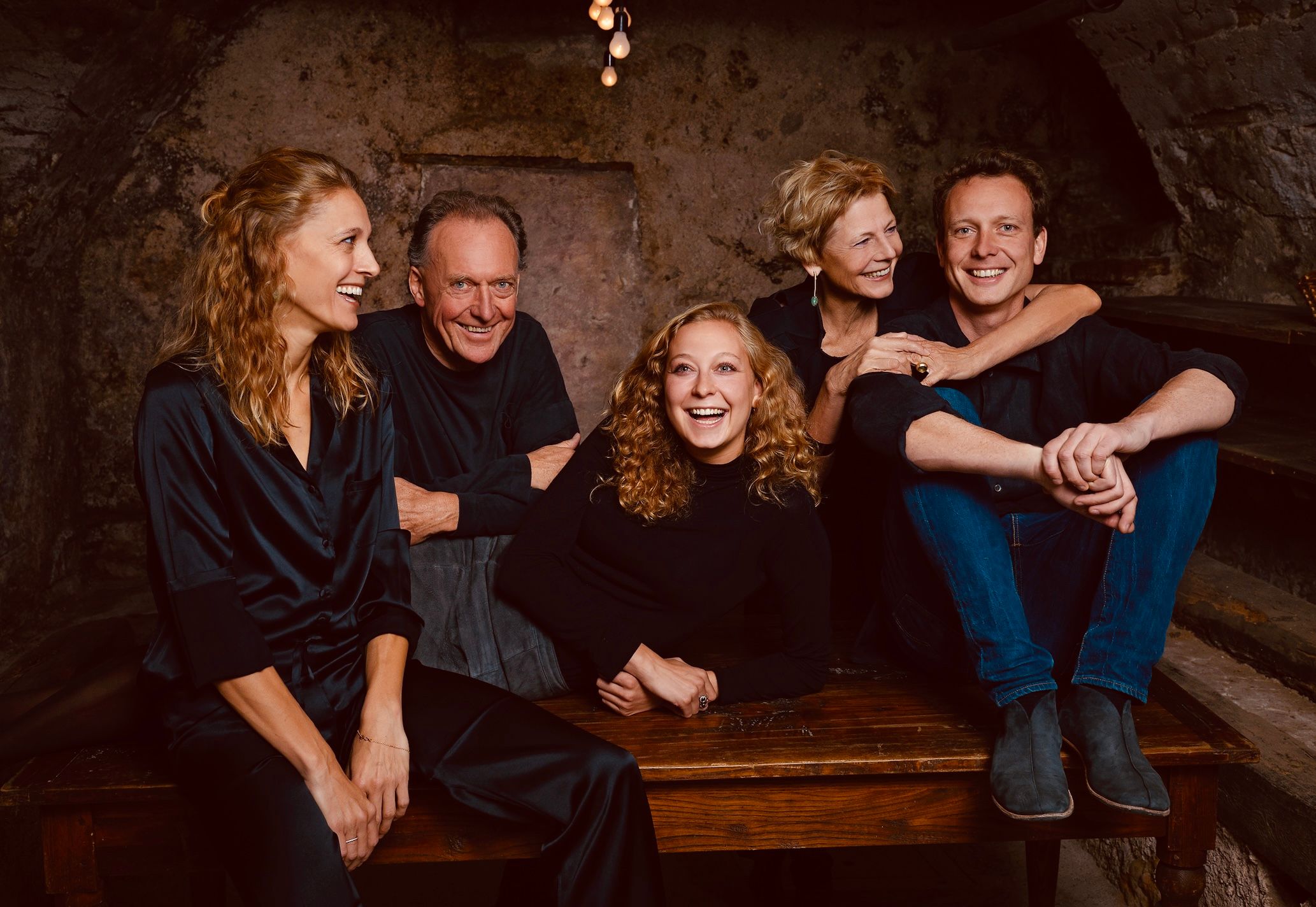“Wine production at Alois Lageder is carbon neutral thanks to a clever winery design that uses a rock wall to chill the wines, solar power and geothermal energy,” writes Garnett.
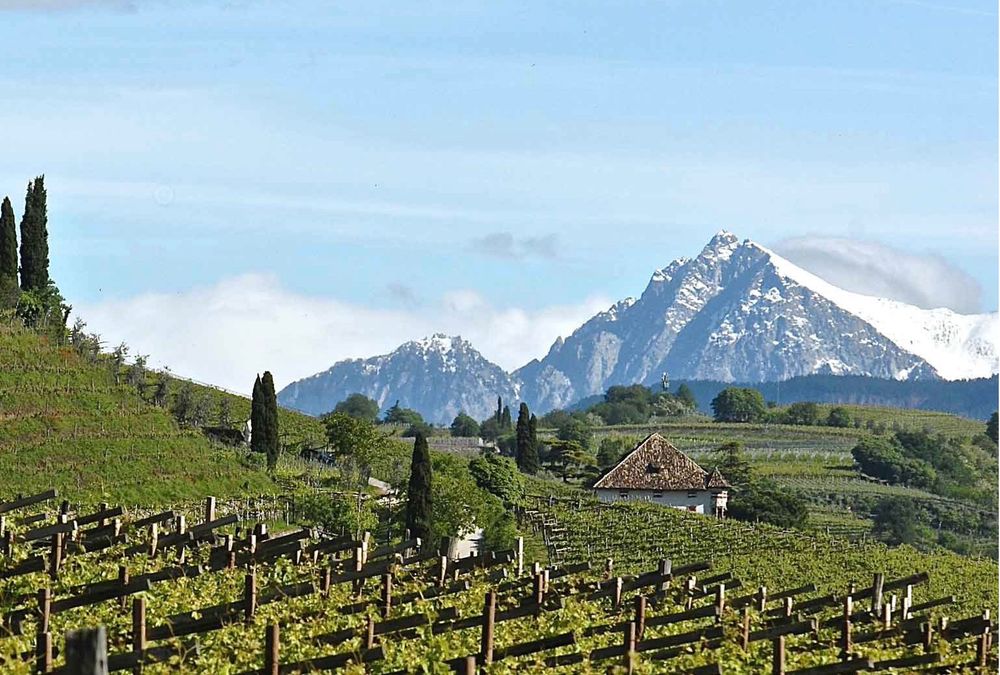
Alois Lageder understood decades ago the value of old vines, organic viticulture, and indigenous varietals growing at altitude
Alto Adige’s Italo-Austrian heritage charts a perilous past. This is the region where the oldest natural human mummy, Ötzi was found embedded in the ice, an arrow set deep in his shoulder. This is the place that facilitated Roman passage across the Alps, where medieval traders and troops in both world wars passed from Italy to Austria.
The sought-after vineyard slopes of Alto Adige fetch a million euros a hectare or more but may as well be priceless as they seldom come up for sale. Land in this bucolic paradise is near impossible to buy and almost always passes down the family line, protected by strictly enforced inheritance laws. Pink Lady apple orchards line the valley floors.
The place feels affluent and worlds apart from impoverished southern Italy. A combination of Alpine houses, fairy-tale turrets, cobbles and tree-lined Haussmann-esque boulevards bestow an Austrian feel, seconded by lederhosen, spotless streets and a meat-rich diet. 62% of the natives speak German, 23% Italian and 5% Ladin. Annexed by Italy in 1919, prior to that the region was Austrian. Locals employ a charming lingual etiquette, politely asking, Italian? Prior to engaging with strangers and vice versa.
Land costs aside, food and clothes are cheaper than in the UK. A cappuccino will set you back €2.5. Life here is good; you can ski, pop to Lake Garda, Venice, Innsbruck or Milan in under three hours. In Bolzano, the region’s capital, most travel by bicycle.
How Alois Lageder fits with Alto Adige
The Northern Italian mountains of Alto Adige, aka Südtirol in the Dolomites, sit beside the Alps, close to the Austrian border. This is the most northern region of Italy with terrain that rises to nearly 4000 metres. The climate is hugely advantageous for the vine, almost Mediterranean with plenty of sun-catching vertiginous slopes, ideal for slow ripening. Diurnal temperature range is key to flavour development; alcohol levels can be fairly robust.
Grape varieties include both international and local, Pinot Bianco, Pinot Noir, Cabernet, Chardonnay, Riesling, Grüner, Sauvignon, Sylvaner & Merlot (introduced by the Hapsburgs) and diminishing amounts of red Schiava, aka Vernatsch, Kerner and Lagrein. Pinot Grigio from this region illustrates what this often-vapid variety can do when grown in the right spot.
The place has a fairy-tale quality, the air is pristine, flowers bloom at every window and alpine cattle bells clank. At Alois Lageder they have harnessed the system of transhumance, bringing the livestock down from the hills in the winter so they might graze outside all year round. This practice controls weeds and attracts birds. The manure brings a profusion of diverse flora and herbs, and the vineyard positively blooms as a result.

Lageder’s Löwengang Estate remains a breathtaking example of 13th century architecture
Alois Lageder and the ‘animation of nature’
Set in Magrè, the Löwengang Estate was bought by the Lageder family in 1934, and remains a breathtaking example of 13th century architecture with frescoed walls, covered porticos, cobbled courtyards and nooks. Art and culture belong in this place. Today, this biodynamic farm is in the hands of fifth-generation winemaker Alois Lageder and his children.
Lageder credits Robert Mondavi for turning him on to organics. Mondavi took him to one side and gave him the kick up the proverbial he needed to wake up and smell the sweet whiff of earth-friendly viticulture. Mondavi reminded Alois that organic farming was nothing new but is, in fact, the old way, dating back thousands of years.
Since 2004, Lageder has gone one step further and is farming biodynamicaly. Where industrial farming is a monoculture battling nature for increased yields, biodynamics attempts to find a balance within the existing rhythms of nature, an equilibrium that Lageder Senior says you can witness in the health of the vines. “It ensures plants are healthy and resistant, which is imperative in the face of climate change and extreme weather.”

Fifth-generation winemaker Alois Lageder and family
The Lageder farm includes 54 acres of limestone, volcanic and marine soils, and vineyards at anywhere between 250 and 1000 metres. It has over 20 grape varieties to pair with myriad microclimates and soils, helpful as the family quest is to find the ideal spot for the ideal grape.
There are also 20 types of cover crops on the Löwengang Estate. Numerous ‘astromaps’ cite root, leaf, flower and sun days based on the zodiac calendar, which I am told is the lunar cycle, biodiversity being the critical purpose. Wine production at Alois Lageder is carbon neutral thanks to a clever winery design that uses a rock wall to chill the wines, solar power and geothermal energy. The Lageders are not afraid to experiment, innovate and, crucially, accept time and nature as their masters.
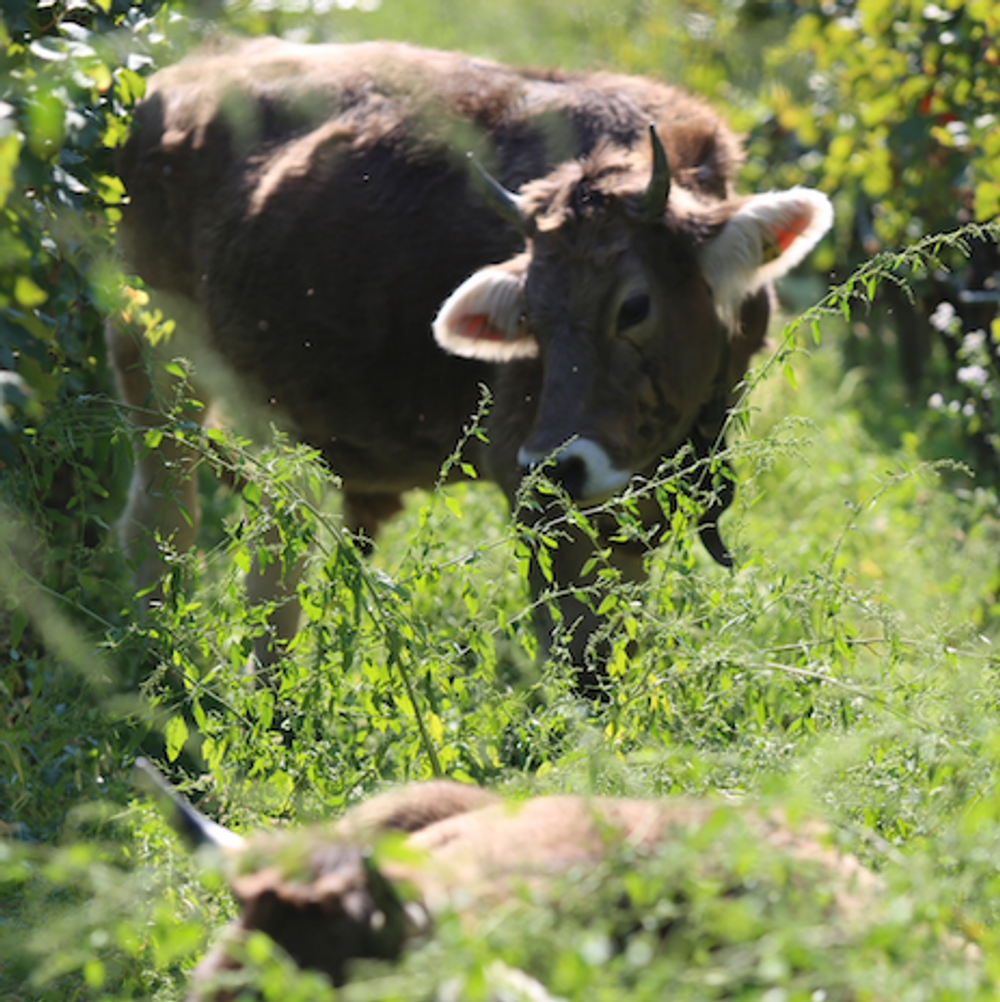
Transhumance helps control weeds, attracts birds and helps a profusion of diverse flora and herbs to grow amongst the vines.
Lageder says this “animation of nature” has improved the quality of the vines dramatically and, quite apart from its direct benefits, is a beautiful spectacle. The sound of clanking cow bells and the gorgeous chaos of naughty dove-grey and fawn, doe-eyed cows making wrong turns en route to their winter grazing amid the vines is genuinely wonderful. A practical system; some of these creatures will end up on a plate, providing organic meat for the family restaurant Paradeis, which works in partnership with 90 vineyards and local vegetable farmers.
Everything at Paradeis is locally sourced. Exquisitely presented mountain charcuterie and sausages, local goats’ cheeses, home-grown vegetables, and wine. This is combined with the most beautiful traditional architecture and subtle interior design. Elements of upcycled salvage and stunning artisanal details hand-crafted by the likes of Emery & Cie serve to elevate the old with the practical new, where needed. The philosophy is very much arts and crafts-based, anti-industrial, functional and beautiful all at the same time.
Alois Lageder spoke of the onset of global warming decades ago – he also understood the value of old vines, organic viticulture, and indigenous varietals growing at altitude. Things that might be considered eccentric, make perfect sense in this fairyland of 13th-century stone; even Bach played on repeat to barrelled wine, powered by the wind, seems about right.
The place is intoxicatingly magical and it hums with life.
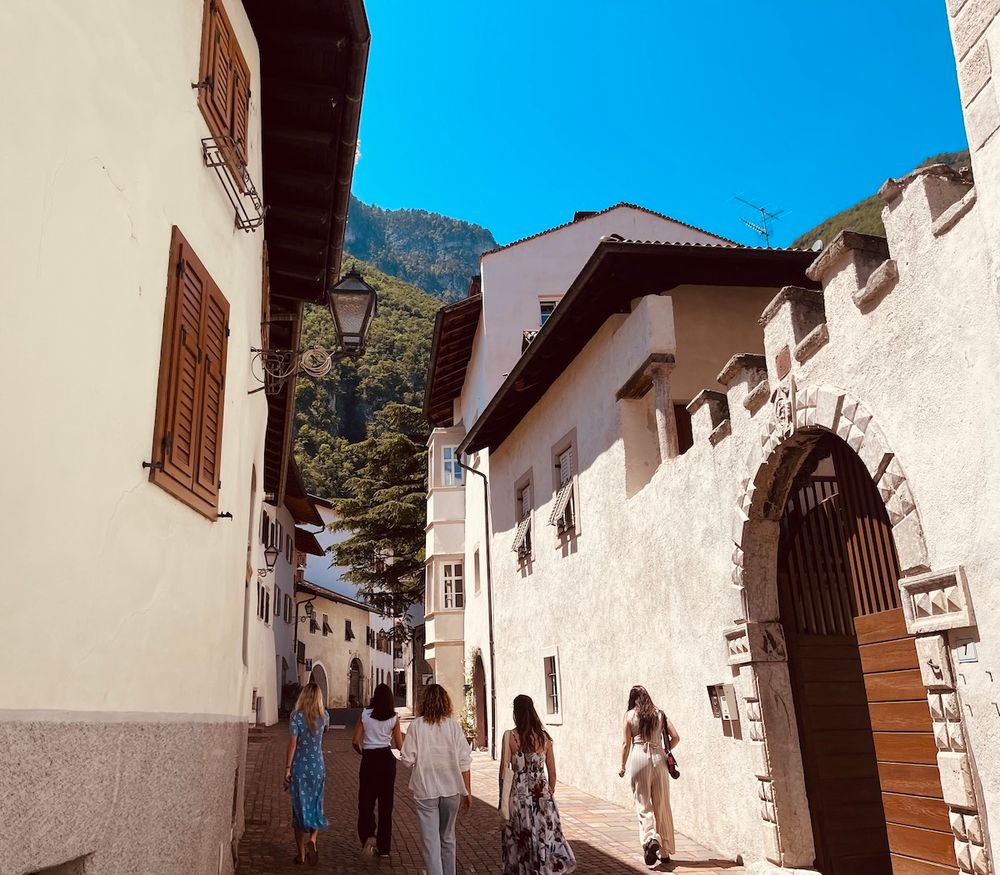
A combination of Alpine houses, fairy-tale turrets, cobbles and tree-lined Haussmann-esque boulevards bestow an Austrian feel
Why Alois Lageder is a natural fit with Bibendum
Bibendum has had Lageder in its portfolio for some two decades. The importer’s buyers appear obsessed with cutting-edge radical winemakers who have a story to tell. Producers such as: Weingut Markus Huber, Paul Jaboulet Aîné and Gérard Betrand are making biodynamic wines at scale; Tutiac are making wines using PIWI* grapes; Provence’s MDCV Group is making Charmat wines in the UK using outmoded Germanic cross-bred varieties. The cooperative Plaimont in South West France has succeeded in turning around what was considered a supremely lame PGI thus forming a utopian project worthy of worldwide attention. Its preservation of ancient drought-resistant varieties at the world’s first ampelographic institute may succeed in reverse-engineering climate change one day. All these agencies are housed in the palatial yet magnanimous Bibendum stable.
*(PIWIS are crosses between European vines and fungus/frost resistant American species, they allow for a huge reduction in pesticide use).
Size and scale appear irrelevant when it comes to Bibendum’s buying strategy. Their buyers are ballsy and comfortable pushing boundaries. A competition cynic, I never-the-less note that they have four wineries in the top ten of the latest comp du jour, The World’s Best Wineries. Their prescience is uncanny and ideal for curating varied wine lists.
I asked Harriet Kininmonth (trading director of Bibendum’s parent company C&C) for the company secrets…
“We aim to be pioneering, inciteful and mindful.”
Is that in response to customer demand or the other way around?
“I think we have a duty of care to produce the unknown, to challenge the norm and push boundaries. We both listen to our consumers, and look at predictive trends and respond to them too.”
“Diversity is really about the buying team; it’s their job to go out and find these extraordinary things when they are travelling the world and bring them back to the Bibendum table.”
As my meandering mind conjures multi-sex wino Indiana Joneses scanning the world wine firmament in khaki, Kininmonth adds, “It’s fundamentally about the customer. We are first and foremost a customer-focused business. We have a duty of care to educate, introduce and inspire. It is absolutely at the core of everything we do.”
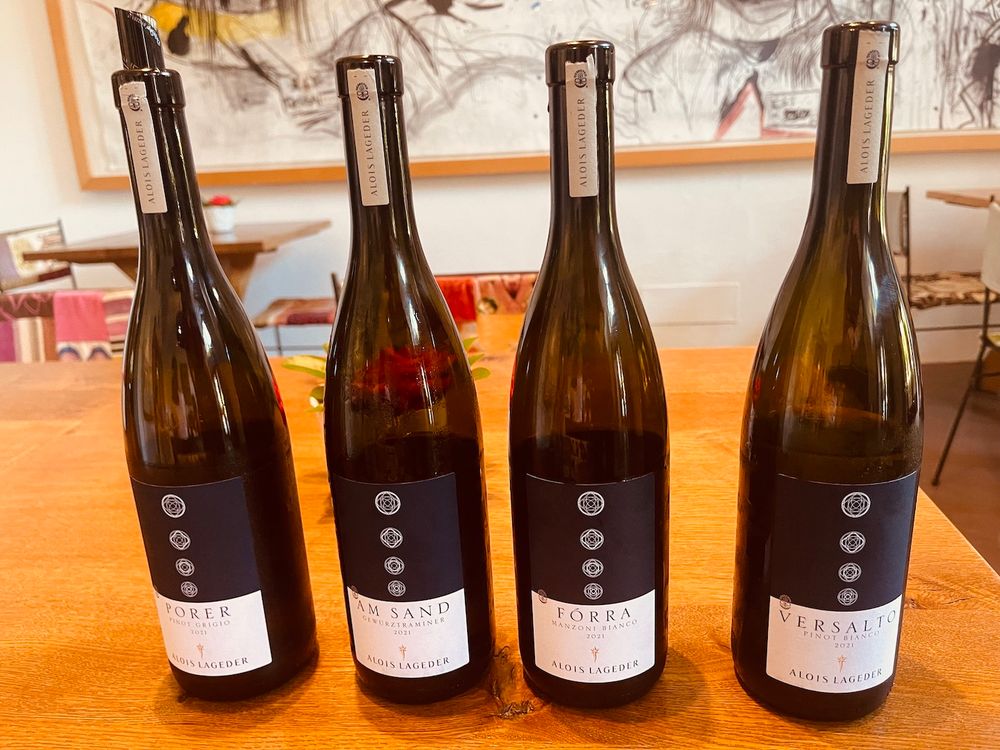
Tasting the wines of Alois Lageder
Pursuing freshness in the face of global warming is critical to Lageder’s portfolio. The vines get cool breezes from Lake Garda in the afternoon and can grow at altitude. Lageder looked at early picking but was not happy with the flavour profile; he looked at pergolas and is trying out Chardonnay, he’s looked into even higher altitudes, but did not want to obstruct the beautiful natural woodland 1000 metres up, which is considered an integral part of the farm. In the winery, freshness is king, and skin contact is used, with stainless steel and carbonic maceration to enhance it.
These wines are from the Composition range of “individual character and strength,” there are many more to try, some experimental and in scant supply.
Alois Lageder Porer Pinot Grigio 2021 12.5%
A loving expression of what some see as a boringly broad grape variety, but not so here. This wine saw skin contact, stainless steel and carbonic maceration. Fresh, fecund, lively and elegantly precise but pithy and textural with a hint of cantaloupe melon, salty flint and peach.
Alois Lageder Am Sand Gewürztraminer, Mitterberg IGT 2021 13%
Grown on several sandy sites in Bassa Atesina. Harvest is staggered to provide freshness, minerality and depth. Noble rot features subtly in the flavour profile too, with notes of passion fruit, candied citrus and yellow apple. This wine is beautifully balanced with white pepper and salty flint, a savoury endive note and Turkish Delight, lavender and rose.
Alois Lageder Fórra Mazone Bianco 2021 13%
Mazone Bianco is a cross between Riesling and Pinot Bianco, created in the 1930s. The juice was left on the skin for several days to create a striking textural profile. Fresh and pithy with a delicate hint of pear yoghurt, citrus, green apple, salty flint, white pepper and a moreish delicious bitter note.
Alois Lageder Versalto Pinot Bianco 2021 12%
The grapes for this wine are up to 63 years old, grown 500m above sea level in Pochi Eastern Alto Adige on sandy soils and limestone. Matured on lees, partial stainless steel and nine months in cask. This wine is intensely fresh and pithy with limoncello, pear and fragrant apple blossom, white peach and salty flint. There is a gorgeous spicy textural element from time spent in wood.
Alois Lageder Löwengang Uvaggio Storico 2020 11.5%
Carmenère, Cabernet Franc, Cabernet Sauvignon and Petit Verdot. A supreme blend of grapes grown on limestone and sand, of ancient vines with minuscule yields, some of the vines used in this blend are 134 years old. Savoury and fresh yet full and round. Redolent with blackberries, cherries, dried lavender, roses, rich earth and electric acidity. The wine is matured in barriques and culminates in a moreishly bitter savoury finish.
Bibendum is a part of the C&C Group which is a commercial partner of The Buyer. To discover more about them click here.
